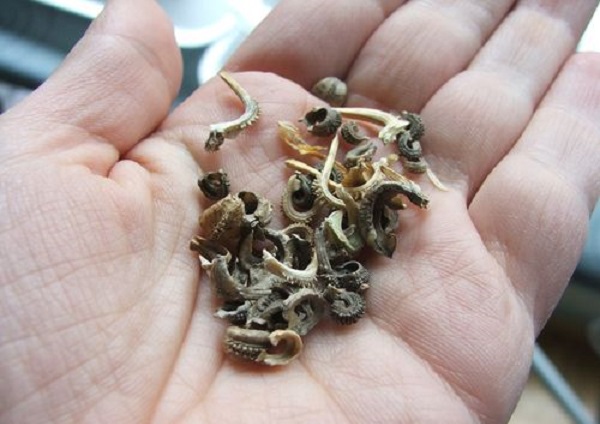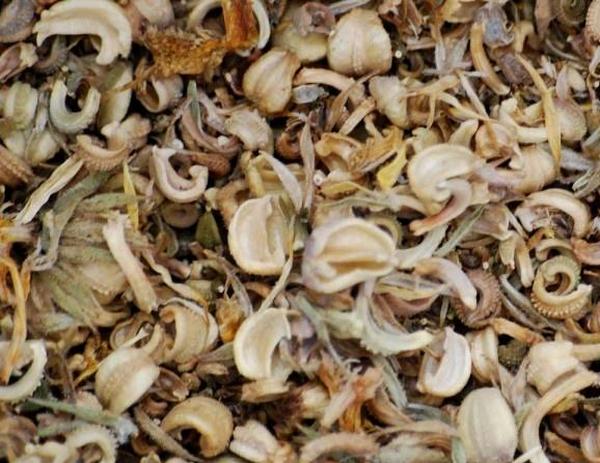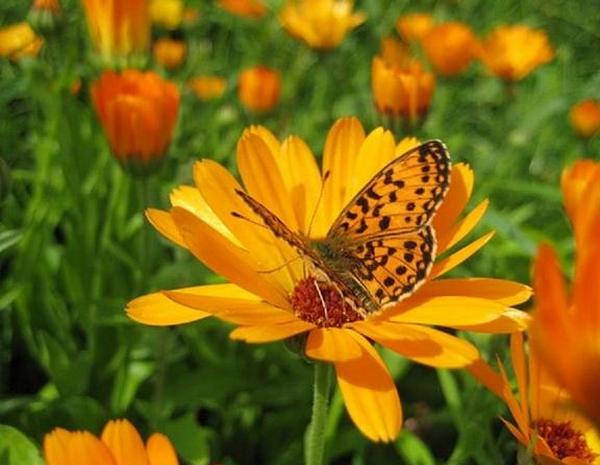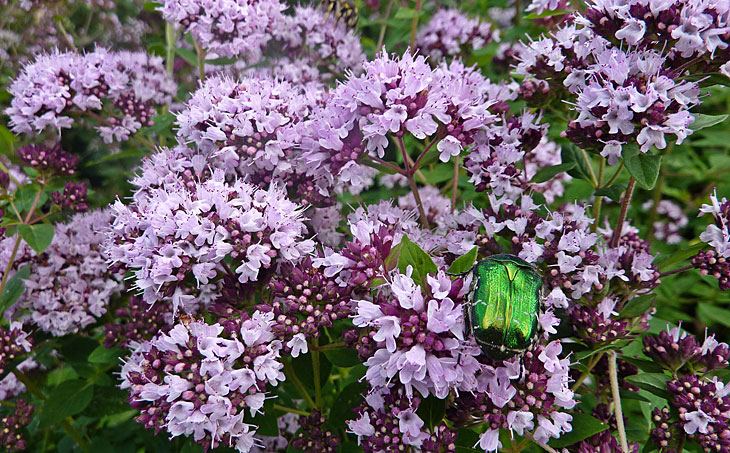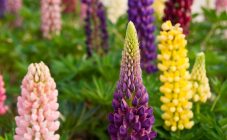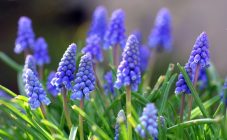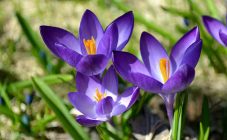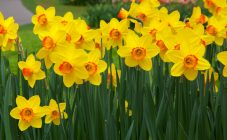Content:
Calendula is an unpretentious medicinal plant also called marigolds. These bright yellow-orange flowers belong to the Astrov family. In the wild, calendula is found in Asia, the Middle East and southern Europe. The healing properties of marigold inflorescences remain dry for up to 2 years. You can also grow culture in your country house for decoration.
Calendula: planting and care in the open field
The plant is considered light-loving, resistant to cold, unpretentious to care for. Care and cultivation of calendula is not particularly difficult, it is cultivated as an annual. Flowering lasts from June until the first frost. Many are interested in whether the calendula is perennial or not? In warm countries, yes. In the middle lane, the plant inevitably dies from frost in winter.
In shape, the flowers can be simple and double. In order for the plant to bloom actively, the most illuminated places should be chosen for planting it. In marigolds growing in the shade, the inflorescences will be small, and the color of the petals will be faded. It is advisable to fertilize the soil in the fall, adding 1 tbsp to the flower bed. a spoonful of potash and phosphorus fertilizers and 3-4 kg of compost. If the soil is heavy and clayey, it is necessary to improve its composition by adding sand. In any case, the soil must be well-drained.
It should not be planted too thickly; weeds in the flowerbed must be removed in a timely manner. The plant is not particularly demanding for watering, the earth is moistened only from time to time.
Calendula varieties
There are only 3 types of calendula: decorative, medicinal. There is also a field calendula, which is considered a weed. The marigolds can be short, medium and tall. The minimum plant height is 45 cm, the maximum is 85 cm. Among the popular varieties are the following:
- Pigmy- a low-growing variety, growing up to 15 cm in height. Inflorescences are small double flowers, the petals of which are painted in golden and cream tones.
- Calypso- also a low-growing plant, growing up to 30 cm. It blooms with large orange inflorescences with a golden tint.
- Radio- medium-sized bush 55 cm high with small hemispherical inflorescences of yellow or orange color.
- Green heart - garden calendula, up to 60 cm tall, with yellow and orange flowers.
- Orange flamingo- a medium-sized plant just over half a meter in height with large orange flowers.
- Pacific Beauty- a tall variety, growing up to 80 cm, with hemispherical flowers of various shades.
Buying seeds of any variety is not a problem today. In the future, seed material can be collected from plants that have grown on their own plot.
Flower propagation
Reproduction of marigolds occurs only by the seed method. You can grow calendula by sowing seeds in open ground, or by seedling. When growing seedlings, flowering occurs 2 weeks earlier.In open ground, seeds can be sown in the fall during the first night frosts or in the spring, when the ground thaws and warms up.
Sowing with seeds
If you plan to grow calendula from seeds, when to plant? In the middle lane, sowing in open ground is carried out in the second or third decade of April. Before spring planting, the soil should be well loosened and filled with humus. If the decorative calendula is planted as a curb plant, it is recommended to lay the seeds in the grooves. When decorating a flower bed, sowing is done pointwise. The optimum depth of planting seeds is 2-3 cm. In autumn planting, the seeds are left in dry soil; in the spring, the flower bed should be watered with warm water immediately after sowing. Seedlings appear in a week, after a month they can be thinned out by transplanting some of the plants to another place. While the seedlings are young, watering should be done 3-4 times a week. In the phase of active growth, calendula can be fertilized with nitrogen fertilization, but you should not get too carried away with fertilizing.
Planting seedlings
If you need an early flowering calendula, cultivation is best done by seedling at home. Sowing seeds at home is done in wooden boxes or a plastic container. For planting, a universal soil purchased at a gardening store is suitable. After seeding the seeds into the grooves to a depth of 2 cm, the crops should be kept under the foil in a room with a temperature of 14-15 ° C. The first shoots will appear in 6 days.
Seedlings are transplanted into open ground when 5-6 full leaves are formed on it. Before this, the plants should be hardened for a week. When planting plants in the ground, an interval of 15-20 cm is observed between them. The seedlings should be removed from the container carefully, trying not to damage the delicate roots. You can use a regular tablespoon for these purposes. After planting, the seedlings are immediately watered.
Marigold care
How to grow calendula correctly? Cultural agrotechnics are very simple. Calendula does not require any special conditions when planting and nursing in the open field. The plant needs moisture for active growth only at the very beginning. In the future, watering is carried out during a drought. In the absence of rain, calendula is watered 2 times a week, immediately after watering, loosening and weeding are performed. The plant usually has enough of those fertilizers that are laid before planting, so feeding is not necessary. To prolong the flowering of decorative varieties, once every 2 weeks, you can apply a complex fertilizer for flowering plants when watering.
Calendula planted on the site further multiplies by self-seeding. The summer resident can only thin out the flower bed and occasionally take care of the plant. To give the bush splendor, it is recommended to pinch the main stem of the plant. To prolong flowering, you need to cut off the faded heads in a timely manner. Leave them only if you plan to collect seeds.
Why isn't calendula blooming? Such a situation is difficult to imagine. The plant may not produce buds only at a too young age or very unfavorable conditions for growth (with a lack of light, nutrition and moisture). Diseases very rarely affect calendula. They usually appear during damp, cool weather, since such conditions are favorable for the multiplication of fungal spores. If dark spots or rotten areas appear on the leaves, they should be removed. After that, the plants are sprayed with fungicides or a solution of copper sulfate.
When to collect seeds
Calendula seeds can be harvested in late August or early September. By this time, the petals on the inflorescences have fallen off, leaving only dried seeds in the center of the head, which are easily separated. The collected seeds are dried in a warm, ventilated room and folded into a paper bag until spring arrives. As a rule, only one bush is enough to collect them. The collected material is more than enough for sowing on the entire site.
In China, calendula symbolizes longevity, in India it is revered as a sacred plant. This flower deserves respect and love, bringing benefits and beauty to people. Given its unpretentiousness, you can safely plant in any garden. Calendula will not disappoint the grower!
